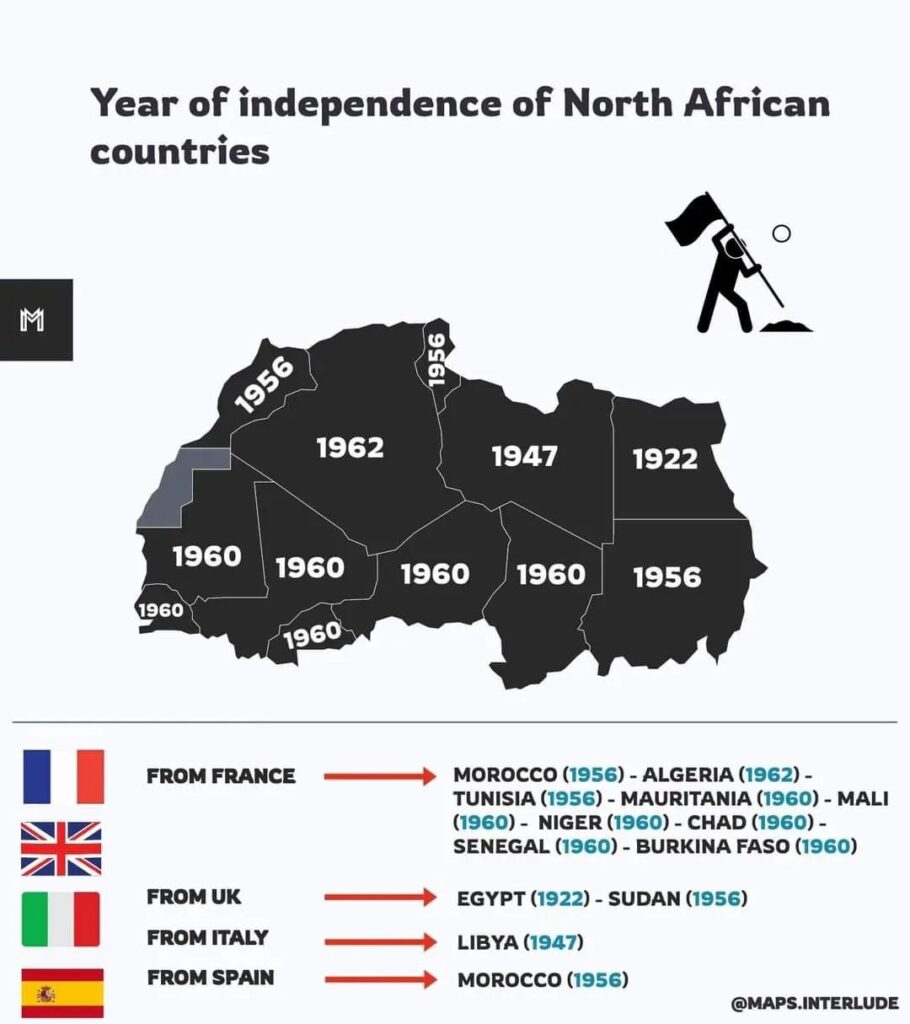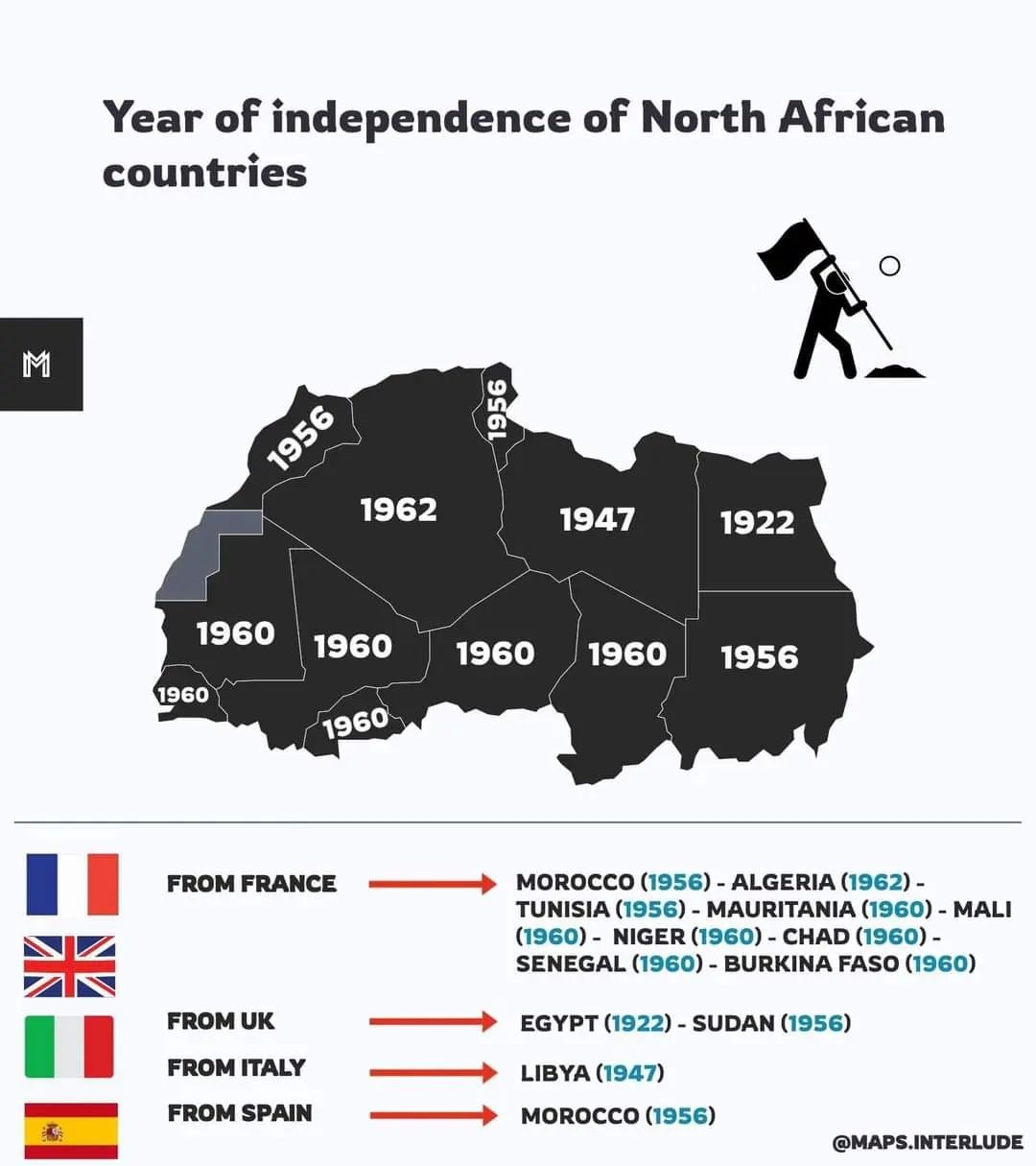Year of independence of North African countries
During the 1950s and 1960s, and into the 1970s, all of the North African states gained independence from their colonial European rulers, except for a few small Spanish colonies on the far northern tip of Morocco, and parts of the Sahara region, which went from Spanish to Moroccan rule.
According to study.com, these countries were, in chronological order of independence: Cameroon, Togo, Madagascar, the Democratic Republic of the Congo, Somalia, Benin, Niger, Burkina Faso, Ivory Coast, Chad, the Central African Republic, the Republic of the Congo, Gabon, Senegal, Mali, Nigeria, and Mauritania. Ghana was one of the first nations in the African continent to gain independence from colonial rule.
The year 1960 is known as the “Year of Africa,” when 17 countries across the continent celebrated the joy, excitement, and possibilities of independence. But liberation in Africa was more than this one moment in the global process of decolonization. Between March 1957, when Ghana declared independence from Great Britain, and July 1962, when Algeria wrested independence from France after a bloody war, 24 African nations freed themselves from their former colonial masters. In most former English and French colonies, independence came relatively peacefully.
Namibia became the world’s newest nation when South Africa formally relinquished control shortly after midnight today (5 p.m. EST Tuesday). So ended an era of colonial rule on a continent once carved up and ruled by European powers hungry for imperial glory.

By 1914, the only independent African states were Liberia and Ethiopia. The area of West Africa that is now called the Democratic Republic of Congo is a good example of what happened to many African countries during the Scramble for Africa.
The West African country of Liberia shares special historical ties to the United States, dating back to its founding in 1822 by former slaves and free-born blacks from the United States under the sponsorship of the American Colonization Society (ACS). The Dutch established a colony in Africa before many other European countries. It is also the first colonial country which came to South Africa.
Why was Africa called Ethiopia?
Ethiopia derives from the classical Greek for “burnt-face” (possibly in contrast to the lighter-skinned inhabitants of Libya). It first appears in Homer’s Iliad and was used by the historian Herodotus to denote those areas of Africa south of the Sahara part of the “Ecumene” (i.e. the inhabitable world).
Who named Africa? the Romans
All historians agree that it was the Roman use of the term ‘Africa’ for parts of Tunisia and Northern Algeria which ultimately, almost 2000 years later, gave the continent its name. There is, however, no consensus amongst scholars as to why the Romans decided to call these provinces ‘Africa’.
Which country was not colonized in Africa?
Battle of Adowa (Ethiopia) As you have already learned, Ethiopia along with Liberia, were the only African countries that were not colonized by Europeans.
What are the 7 European countries that colonized Africa?
By 1900 a significant part of Africa had been colonized by mainly seven European powers—Britain, France, Germany, Belgium, Spain, Portugal, and Italy. After the conquest of African decentralized and centralized states, the European powers set about establishing colonial state systems.
Most nations in Africa were colonized by European states in the early modern era, including a burst of colonization in the Scramble for Africa from 1880 to 1900. But this condition was reversed over the course of the next century by independence movements. Here are the dates of independence for African nations.
| Country | Independence Date | Prior ruling country |
|---|---|---|
| Liberia, Republic of | July 26, 1847 | – |
| South Africa, Republic of | May 31, 1910 | Britain |
| Egypt, Arab Republic of | Feb. 28, 1922 | Britain |
| Ethiopia, People’s Democratic Republic of | May 5, 1941 | Italy |
| Libya (Socialist People’s Libyan Arab Jamahiriya) | Dec. 24, 1951 | Britain |
| Sudan, Democratic Republic of | Jan. 1, 1956 | Britain/Egypt |
| Morocco, Kingdom of | March 2, 1956 | France |
| Tunisia, Republic of | March 20, 1956 | France |
| Morocco (Spanish Northern Zone, Marruecos) | April 7, 1956 | Spain |
| Morocco (International Zone, Tangiers) | Oct. 29, 1956 | – |
| Ghana, Republic of | March 6, 1957 | Britain |
| Morocco (Spanish Southern Zone, Marruecos) | April 27, 1958 | Spain |
| Guinea, Republic of | Oct. 2, 1958 | France |
| Cameroon, Republic of | Jan. 1 1960 | France |
| Senegal, Republic of | April 4, 1960 | France |
| Togo, Republic of | April 27, 1960 | France |
| Mali, Republic of | Sept. 22, 1960 | France |
| Madagascar, Democratic Republic of | June 26, 1960 | France |
| Congo (Kinshasa), Democratic Republic of the | June 30, 1960 | Belgium |
| Somalia, Democratic Republic of | July 1, 1960 | Britain |
| Benin, Republic of | Aug. 1, 1960 | France |
| Niger, Republic of | Aug. 3, 1960 | France |
| Burkina Faso, Popular Democratic Republic of | Aug. 5, 1960 | France |
| Côte d’Ivoire, Republic of (Ivory Coast) | Aug. 7, 1960 | France |
| Chad, Republic of | Aug. 11, 1960 | France |
| Central African Republic | Aug. 13, 1960 | France |
| Congo (Brazzaville), Republic of the | Aug. 15, 1960 | France |
| Gabon, Republic of | Aug. 16, 1960 | France |
| Nigeria, Federal Republic of | Oct. 1, 1960 | Britain |
| Mauritania, Islamic Republic of | Nov. 28, 1960 | France |
| Sierra Leone, Republic of | Apr. 27, 1961 | Britain |
| Nigeria (British Cameroon North) | June 1, 1961 | Britain |
| Cameroon(British Cameroon South) | Oct. 1, 1961 | Britain |
| Tanzania, United Republic of | Dec. 9, 1961 | Britain |
| Burundi, Republic of | July 1, 1962 | Belgium |
| Rwanda, Republic of | July 1, 1962 | Belgium |
| Algeria, Democratic and Popular Republic of | July 3, 1962 | France |
| Uganda, Republic of | Oct. 9, 1962 | Britain |
| Kenya, Republic of | Dec. 12, 1963 | Britain |
| Malawi, Republic of | July 6, 1964 | Britain |
| Zambia, Republic of | Oct. 24, 1964 | Britain |
| Gambia, Republic of The | Feb. 18, 1965 | Britain |
| Botswana, Republic of | Sept. 30, 1966 | Britain |
| Lesotho, Kingdom of | Oct. 4, 1966 | Britain |
| Mauritius, State of | March 12, 1968 | Britain |
| Swaziland, Kingdom of | Sept. 6, 1968 | Britain |
| Equatorial Guinea, Republic of | Oct. 12, 1968 | Spain |
| Morocco (Ifni) | June 30, 1969 | Spain |
| Guinea-Bissau, Republic of | Sept. 24, 1973 (alt. Sept. 10, 1974) | Portugal |
| Mozambique, Republic of | June 25. 1975 | Portugal |
| Cape Verde, Republic of | July 5, 1975 | Portugal |
| Comoros, Federal Islamic Republic of the | July 6, 1975 | France |
| São Tomé and Principe, Democratic Republic of | July 12, 1975 | Portugal |
| Angola, People’s Republic of | Nov. 11, 1975 | Portugal |
| Western Sahara | Feb. 28, 1976 | Spain |
| Seychelles, Republic of | June 29, 1976 | Britain |
| Djibouti, Republic of | June 27, 1977 | France |
| Zimbabwe, Republic of | April 18, 1980 | Britain |
| Namibia, Republic of | March 21, 1990 | South Africa |
| Eritrea, State of | May 24, 1993 | Ethiopia |
| South Sudan, Republic of | July 9, 2011 | Republic of the Sudan |
Notes:
- Ethiopia is usually considered to have never been colonized, but following the invasion by Italy in 1935-36 Italian settlers arrived. Emperor Haile Selassie was deposed and went into exile in the UK. He regained his throne on 5 May 1941 when he re-entered Addis Ababa with his troops. Italian resistance was not completely overcome until 27th November 1941.
- Guinea-Bissau made a Unilateral Declaration of Independence on Sept. 24, 1973, now considered as Independence Day. However, independence was only recognized by Portugal on 10 September 1974 as a result of the Algiers Accord of Aug. 26, 1974.
- Western Sahara was immediately seized by Morocco, a move contested by Polisario (Popular Front for the Liberation of the Saguia el Hamra and Rio del Oro).

